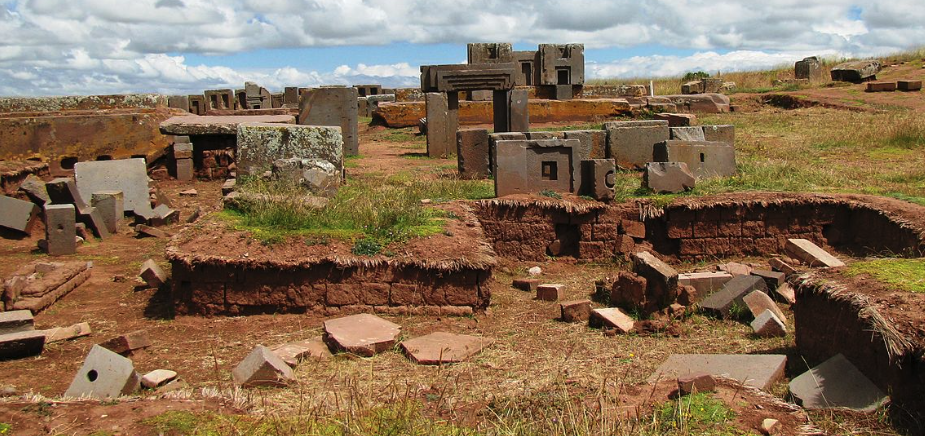Today we will be taking a closer look at the Tiahuanaco complex, located near the majestic Lake Titicaca in South America. The site of great interest to many archaeologists and is near the mysterious site of Puma Punku.
Tiahuanaco
Tiahuanaco and temple complex are thought to have been built by the ancient Tiwanaku culture, which flourished in the area before recorded history. The largest structure in the complex is the Akapana Pyramid. It is a step pyramid that measures 257 meters wide and 197 meters broad at its maximum point. The structure is believed to have been built to a height of nearly 17 meters and features a sunken court at its center. On the structure’s western side, we see a staircase decorated with sculptures.
Archaeological surveys of Tiwanaku have revealed that the largest blocks used in constructing the Pyramid weigh nearly 67 tons. This fact alone raises many questions about the ancient techniques used to transport and cut these massive stones. How did they manage to quarry and move these blocks? And what was the purpose of such a monumental structure?
An Ancient Mystery
But Tiahuanaco is not the only amazing structure in the area. Puma Punku is located southwest of the Kalasasaya Temple in Aymara. The site is one of the world’s most impressive and inexplicable sites. Its name means “La Puerta del Puma” or the “Door of the Puma.”
The site consists of an unwalled western court, a central esplanade, a mound of megalithic stone terraces, and a walled court to the west.
Puma Punku’s Name
Puma Punku gets its name from “La Puerta del Puma” or the “Door of the Puma.” This name is fitting, as the site is believed to have been a doorway to an ancient civilization. The complex includes an unwalled western court, a central esplanade, a mound of megalithic stone terraces, and a walled court to the west. It is believed to date back to at least BCE 536, making it over 1,400 years old.
This site is particularly interesting because of the precise stonework used in its construction. The blocks that make up the site are massive and weigh up to 100 tons. Researchers say they were cut and shaped with a level of precision that would be difficult to achieve with modern tools. Additionally, some of the stones came from a quarry almost 60 miles away.
Fascinating Stonework
The gateways at Puma Punku are particularly fascinating. Several miniature gates, which are perfect replicas of once-standing full-size gateways, are found at the site. It is believed that at least five gateways (and several blind miniature gateways) were integrated into the Puma Punku complex. The foundation platform of Puma Punku supported as many as eight andesite gateways and fragments of five andesite gateways.
The Gate of the Sun
The Gate of the Sun is a particularly significant find, as it is a massive stone structure covered in intricate carvings. Some of the carvings depict what appear to be complex astronomical calculations. Markings on the stones has led some to speculate that the people who built Puma Punku deeply understood the cosmos.
The site’s stones, alignment, and magnetism present a huge headache for modern researchers. Some also claim that researchers at the site are ignoring more huge structures discovered after using ground penetrating radar.
Five Incredible Facts
- The stones at Puma Punku consist of diorite and granite, two of the world’s hardest and most durable stones. This has led some researchers to speculate that the ancient builders had access to advanced tools and technology.
- Many stones at Puma Punku display magnetic anomalies, leading some to speculate that the ancient builders may have known about magnetism and its properties.
- The stones at Puma Punku fit together with such precision that it is impossible to fit a piece of paper between them. This level of precision is unprecedented in ancient architecture.
- Some stones at Puma Punku weighed as much as 130 tons and were transported from quarries over 60 miles away.
- Designs and layout of Puma Punku are highly sophisticated, featuring intricate interlocking blocks and a complex drainage system. The site also appears to have been aligned with astronomical phenomena, such as the winter solstice.
So who were the people who built Puma Punku? And how did they achieve such incredible feats of engineering and stonework? We may never fully answer these questions. But one thing is for sure – the site is a doorway to the mysterious past, and we must continue studying it to understand the ancient world better.
If you like reading about amazing sites in North America, check this article out.
